April is a great month for diving, with a variety of unusual highlights. You can encounter whale sharks in Honduras and Australia, dive between two tectonic plates in Iceland and explore Cousteau’s bizarre Conshelf II. Here are our picks for the best April dive destinations.
The Seychelles
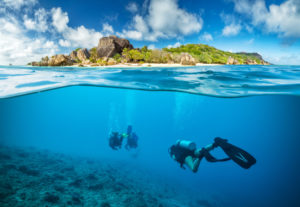
With over 100 islands and famous white-sand beaches, the Seychelles is a great destination for laid-back sailing and dive adventures. April is the best month for calm waters, allowing you to reach more remote dive sites.
Don’t miss the Sister Islands when diving in the Seychelles, which are only accessible by boat. These two small, privately-owned islands are pristine, with uncrowded dive sites. The coral reef at Grande Soeur is teeming with life and fringed by pink-granite rocks, making for beautiful photo opportunities. You can enjoy both hiking and diving there.
Head to the uninhabited island of Petite Soeur for unspoiled tropical forest and more coral-reef diving. Dive in at Sister Bank and you’ll be swept past rock formations and swim-throughs, giving you a chance to spot hawksbill turtles and the rare Armitage angelfish.
Ningaloo Reef, Western Australia
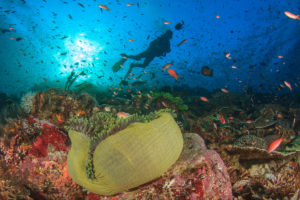
While the Great Barrier Reef is rightly famous, some of the country’s best dive sites are in Western Australia. The Ningaloo Coast, a UNESCO World Heritage Site, is a prime example.
Hundreds of whale sharks gather at Ningaloo Reef from March to June, brought in by plankton blooms and coral spawning. Go diving in Western Australia in April and you’ll likely swim with these ocean giants, plus enjoy uncrowded dive sites. If you’re lucky you might even witness mass-coral spawning.
This special reef also hosts manta rays, dolphins and turtles all year. With over 500 species of fish, plus hundreds of corals and critters, there’s definitely something for every diver.
Bay Islands, Honduras
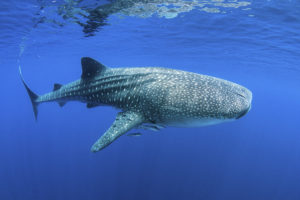
If you’re a fan of sheer wall diving and remote seamounts, Honduras liveaboard diving is a great April dive choice. The weather is warm and dry, and you have the chance to spot whale sharks.
Utila’s northern side is washed by the open ocean, offering exciting deep wall dives and stalactite-covered caves. Be sure to look to the blue for whale sharks, marlin and dolphins passing by.
If you enjoy easier-paced diving, check out Utila’s southern side. There are sheltered shallow dives at the fringing reef, with plenty of coral and fish. The southern and eastern sides have numerous deep seamounts and pinnacles, washed by strong currents.
The Cayman Trench off Roatan is well worth diving for dramatic canyons and walls plunging into the depths. This trench is best-known for whale sharks and rare black corals. Don’t miss Mary’s Place, a deep, volcanic crack that’s covered in corals and sea fans with plenty of critters about.
Sudan
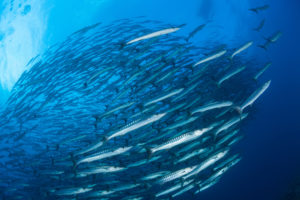
Sudan might be off your diving radar, but it won’t be for long. It offers pristine coral reefs, world-class wrecks and healthy shark populations. April is a great time to catch the end of the hammerhead-shark season and enjoy the best visibility.
Angarosh is a deep plateau where you can encounter hammerheads and tiger sharks patrolling the depths. There are plenty of reef sharks, plus barracuda and tuna to spot before rising to the shallow coral reef. Colorful and teeming with fish, the reef is a great place for a safety stop.
Cousteau’s Conshelf II offers the chance to dive a part of Cousteau’s underwater living projects. Once a series of underwater habitats that had electricity, air-conditioning and fresh water, you can now see what remains. The old habitat is surrounded by a pretty coral reef with numerous gray reef sharks, silkies and silvertips. November to April is the best time for encountering hammerhead sharks here.
Silfra, Iceland
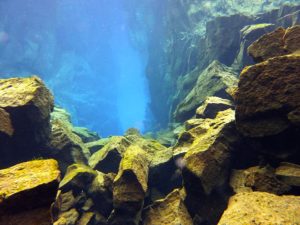
If you want to experience truly exceptional dive visibility and a unique dive experience, visit Iceland’s Silfra fissure. The water might be chilly, but the reward is well worth it. April is a great time to visit, before the busier summer season, and you’ll avoid the challenging winter conditions.
Immerse yourself at Silfra and you’ll diving between the North American and Eurasian tectonic plates at the same time. The landscape is understandably dramatic, and the water is crystal-clear, with visibility more than 328 feet (100 m). Be warned that it’s a cold dive no matter when you come at 35 to 39 F (2 to 4 C), so pack warm to make the most of your dives there.
Divers and writers at LiveAboard.com contributed this article.

